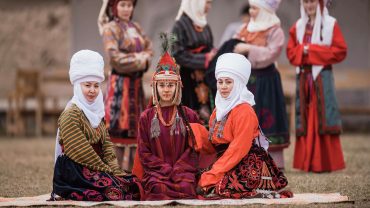Kyrgyz national game
Kok-boru (kek-boru) is a Kyrgyz national sports game that can be called football on horseback. The only ball in such a game is…a goat carcass.
In Kyrgyz, “kok-boru” means “blue wolf”. In ancient times, this meant that a group of strong horsemen on horseback chased a wolf. The fastest rider caught up with the beast, killed it with a club on the head and put the wolf across the saddle. And other riders tried to take away the man’s prey.
Later, in villages, the Kyrgyz stopped hunting wolves and began to play ulak tartysh – tug of the goat according to slightly modified rules. The famous writer Chingiz Aitmatov called this game goat-picking in the work “Goodbye, Gyulsary!”
After that, it stuck: kok-boru is goat–picking. Although the goat is not torn apart, the game is still quite cruel. But every year it gains a lot of viewers thanks to its entertainment. Several times they tried to replace the real carcass with a dummy, but this was accompanied by great inconveniences.
Previously, kok-boru was considered a kind of training before hunting and possible war. All the men of the village participated in the game. They trained the speed of movement on horseback, maneuverability and other skills.
Today’s game of kok-boru is a kind of fusion of the game and horse racing. Only strong men participate in it. Also, only trained horses are taken for the game.
There are three versions of the game:
In the first – sports version – two teams of 8-12 people on horseback gather in the center of the designated field, where the carcass of a dead goat lies, and begin to fight for it. The goat has a strong and long coat, so riders can easily grab the animal without fear that something will break. Teams are allowed to grab the carcass from any point within a special field and take it away from rivals. The task is to keep the carcass at home. Having taken possession of the carcass, the team must throw it into the opponents’ goal. The gate is called a “tai-kazan” (a hollow in the ground in the form of a ring). Such a game takes place under the supervision of three riders of the equestrian judging panel. Previously, in kok-boru, it was allowed to use physical force against opponents and beat them with a kamcha (leather whip) or feet. Now it is forbidden. And for the use of physical force, players are disqualified altogether. The sports game includes three periods of 20 minutes each. The victory is awarded to the team that won by the number of “goals” against the opponents.
In the second version, the people’s version, the team that took possession of the goat must bring the carcass to the territory of its village, where the other team no longer has the right to take it away.
In the third version – alaman ulak – any number of players can take part. Often it reaches thousands.
Traditionally, after the game, kuurdak – roast is prepared from the carcass of a goat. There is a belief that goat meat after goat breeding is endowed with healing properties. During the game, hundreds of hands touch the goat, and it is believed that among this number could well be the hands of a person who is endowed with holiness.
Kyrgyzstan became the first country to announce this game at the international level. In 1998, the Kyrgyz National Kok-boru Federation was established here. Three years later, the International Kok-boru Federation emerged, and then federations of this game appeared in Uzbekistan, Tajikistan, Afghanistan, Pakistan, Mongolia, Turkey, Russia and even China.
Today, kok-boru is played in many countries of the world, including the USA. Some countries have upgraded the game and made it less violent. But adherents of the national Kyrgyz kok-boru consider this is to be wrong.
Kyrgyzstan has also become the initiator country of the World Nomad Games, which have been held since 2014. Kok-boru became one of the first sports to be included in the competitive program of the games. Also, kok-boru is a popular game during the celebration of Nooruz. Each game attracts hundreds of spectators.






Comment (0)